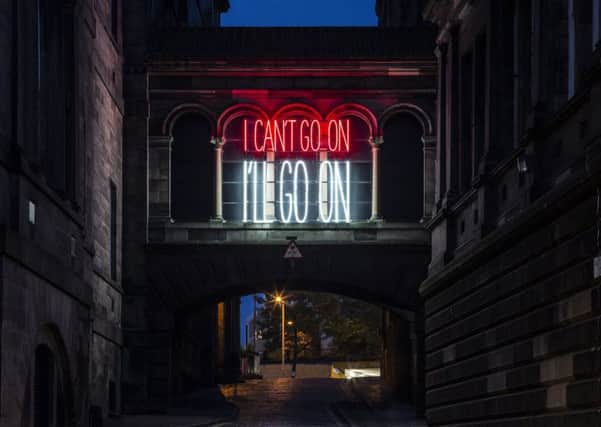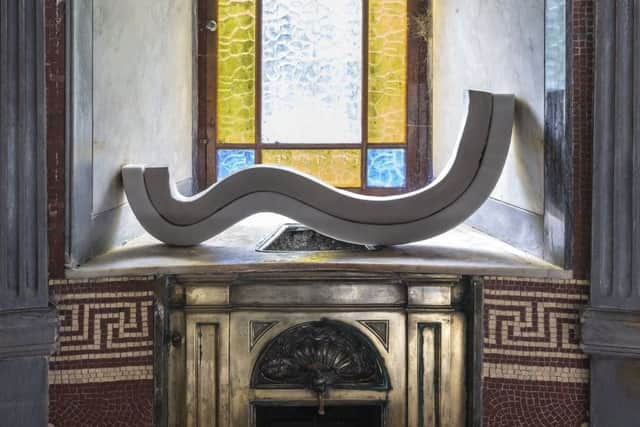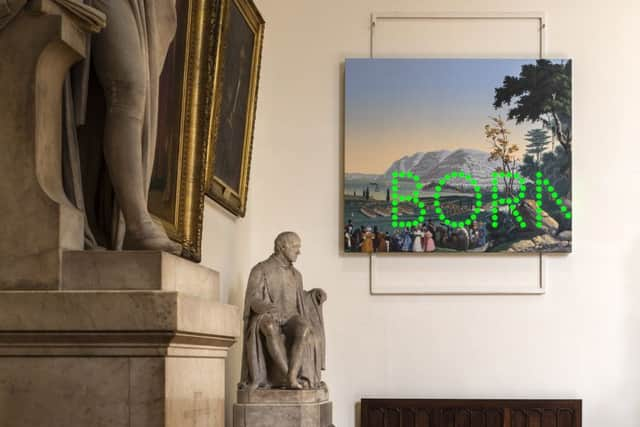Art review: Edinburgh Art Festival Commissions Programme - Stories for an Uncertain World


Alfredo Jaar: Bridge of Sighs, South College Street ****
Nathan Coley: The Future is Inside Us, It’s not Somewhere Else, Parliament Hall ****
Corin Sworn: Habits of Assembly, Edinburgh College of Art ***
Advertisement
Hide Ad

Rosalind Nashashibi, Scottish National Gallery of Modern Art ****
Sriwhana Spong: castle-crystal, French Institute ***
Lunnching the 16th Edinburgh Art Festival on 24 July, festival director Sorcha Carey reminded us that, even as we ate pastries in Collective’s new Calton Hill space, Theresa May was meeting the Queen to resign as Prime Minister, making way for the newly elected Boris Johnson. We live in times, she reminded us, that we could not have foreseen; uncertain, anxious times in which previously held certainties are crumbling and the future is unknown.
In general, contemporary art is not very good at addressing the times directly in a political sense, but it can park up next to them, shine a light on them from a fresh angle. This year’s Edinburgh Art Festival commissions are grouped on the theme ‘Stories for an Uncertain World’, so one might ask what these five artists are bringing to the conversation about the anxious times in which we live.


In Willy Russell’s play Educating Rita, Rita is asked to write an essay on how to improve a production of Ibsen’s Peer Gynt. When questioned about the brevity of her answer – “Do it on the radio” – she explains that “encapsulated all her ideas into one line”. That’s something art can do, and it’s what Chilean artist Alfredo Jaar does with the neon text adorning the ‘Bridge of Sighs’ on South College Street: “I can’t go on, I’ll go on.”
The closing line of Beckett’s 1953 novel The Unnamable is full of ambiguities: it’s contradictory; it can be despairing or triumphant, depending on your mood; it’s timeless, yet perhaps never as timely as in the Johnson/Trump/Brexit world. All this is the genius of Beckett, of course; all Jaar has done is spell it out in neon. It’s a risky strategy: get it wrong and the work will look slight. Get it right, as Jaar has, and you’ve put your finger on the pulse of the times.
With Nathan Coley’s new work, The Future is Inside Us, It’s not Somewhere Else, the context is more than half the game. The works are in Parliament Hall, the austerely grand space where the Scottish Parliament met prior to 1707. The very fact of Coley’s intervention – removing several portraits in the process – feels like a bold gesture in a place of power.
Advertisement
Hide AdColey uses light boxes to project lines of text on to sections of elite wallpaper (used in the White House) based on early 19th paintings of America. They are European, colonial visions of a country which perhaps never existed, and belong to a very different world from the texts, which are streetsy and defiant: ‘We are the monument’, ‘You don’t know me’, ‘You better not never tell nobody but God’, and perhaps most revealingly, ‘Born’.
These are voices not normally heard in this place of power, law, hierarchy and the past. They might be the voices of those on the outside but who, by virtue of being young, of being ‘born’, are those to whom the future belongs.
Advertisement
Hide AdThe physical space in which the work is shown is also important in Corin Sworn’s Habits of Assembly. Within the newly refurbished sculpture court in Edinburgh College of Art, she has built three rooms out of metal struts which look and feel a bit like a cage, placing in them two films and a voice work made in collaboration with dancers Kai-Wen Chuwang and Stephanie McMann, musician Jer Reid and poet Colin Herd.
The dancers’ movement mimics gestures taken from ordinary life, and also reference (among other things) time and motion studies done in the 1920s to make workers more efficient. Herd’s poetic text is at times anxious, at times absurd: “Too much on your plate,” a voice murmurs. “It seems like you’ve got things under control”; “Your task is to remember where you parked.” It can take a while to work out what Sworn is doing, but spend time with this work and you begin to get a sense of a set of disparate reflections on life in a world in which people have too much to do, much of it meaningless, and in which we like to think we are in control, but often just feel imprisoned.
Rosalind Nashashibi’s new two-part film, shown in an upstairs room at the Scottish National Gallery of Modern Art (Modern One), takes its inspiration from The Shobies’ Story by Ursula K Le Guin about a group of space travellers who travel at light speed but, in doing so, lose the linear nature of life and their ability to communicate. This is overlaid with footage from a holiday she spent with her two children and a group of friends in a beach house in Lithuania.
Over the course of the 45-minute film, the beautiful, bleak, alien landscape, and the insularity of the group in the house, recalls Le Guin’s travellers. The strange, occasionally threatening atmosphere is juxtaposed with scenes from domestic life: meals being cooked, children being put to bed, all beautifully shot. It becomes a film about community – in this case, the kind of multi-cultural, multi-lingual community we are learning not to take for granted – about what the contemporary family might look like, and the importance of stories.
Sriwhana Spong focuses down even further, making work which is about finding a space in which individual can flourish. A key inspiration for her ten-minute film, castle-crystal is St Teresa of Avila’s The Interior Castle, which Spong understands not as a work of religious contemplation but an expression of a woman finding an imaginary space in which she can freely think and write and, perhaps, visualise a different future.
Appropriately, she has constructed a magical space in the French Institute for her work, also making a delicated series of intervention at St Bernard’s Well near Stockbridge, the neo-classical structure built over what was believed to be a healing spring. However, while her film has moments of beauty, her work is heavily reliant on a personal symbolic language which risks excluding the viewer.
Advertisement
Hide AdThe five commissions, which will take art lovers across the length and breadth of the city centre, are only a fraction of the shows in this year’s Edinburgh Art Festival. After a day on the trail, the ardent but footsore art fan might find themselves back in South College Street finding a fresh resonance in Alfredo Jaar: “I can’t go on, I’ll go on.” I fully expect to.
The Edinburgh Art Festival runs until 25 August